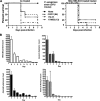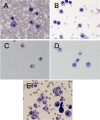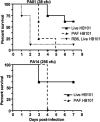Inescapable need for neutrophils as mediators of cellular innate immunity to acute Pseudomonas aeruginosa pneumonia
- PMID: 19805527
- PMCID: PMC2786465
- DOI: 10.1128/IAI.00501-09
Inescapable need for neutrophils as mediators of cellular innate immunity to acute Pseudomonas aeruginosa pneumonia
Abstract
Pseudomonas aeruginosa is a leading cause of pneumonia, and many components of the innate immune system have been proposed to exert important effects in preventing lung infection. However, a vigorous experimental system to identify an overriding, key effector mediating innate immunity to lung infection has not been utilized. As many of the important components of innate immunity are involved in recruitment and activation of polymorphonuclear neutrophils (PMNs) to infected tissues, we hypothesized that the cells and factors needed for their proper recruitment to the lung comprised the major mediators of innate immunity. In neutropenic mice, intranasal (i.n.) doses of P. aeruginosa as low as 10 to 100 CFU/mouse produced a fatal lung infection, compared with 10(7) to >10(8) CFU for nonneutropenic mice. There was only a very modest increased mortality in mice lacking mature lymphocytes and no increased mortality in mice depleted of alveolar macrophages when administered i.n. P. aeruginosa. Recombinant mouse granulocyte colony-stimulating factor increased survival of neutropenic mice after i.n. P. aeruginosa inoculation. MyD88(-/-) mice, which cannot recruit PMNs to the lungs, were highly susceptible to fatal P. aeruginosa lung infection, with bacterial doses of <120 CFU being lethal. Activation of a MyD88-independent pathway for PMN recruitment to the lungs in MyD88(-/-) mice resulted in enhanced protection against P. aeruginosa lung infection. Overall, in the absence of PMNs, mice cannot resist P. aeruginosa lung infection from extremely small bacterial doses. There is an inescapable requirement for local PMN recruitment and activation to mediate innate immunity to P. aeruginosa lung infection.
Figures








References
-
- Babalola, C. P., C. H. Nightingale, and D. P. Nicolau. 2004. Adjunctive efficacy of granulocyte colony-stimulating factor on treatment of Pseudomonas aeruginosa pneumonia in neutropenic and non-neutropenic hosts. J. Antimicrob. Chemother. 53:1098-1100. - PubMed
-
- Bodey, G. P. 2001. Pseudomonas aeruginosa infections in cancer patients: have they gone away? Curr. Opin. Infect. Dis. 14:403-407. - PubMed
Publication types
MeSH terms
Grants and funding
LinkOut - more resources
Full Text Sources
Other Literature Sources
Research Materials

